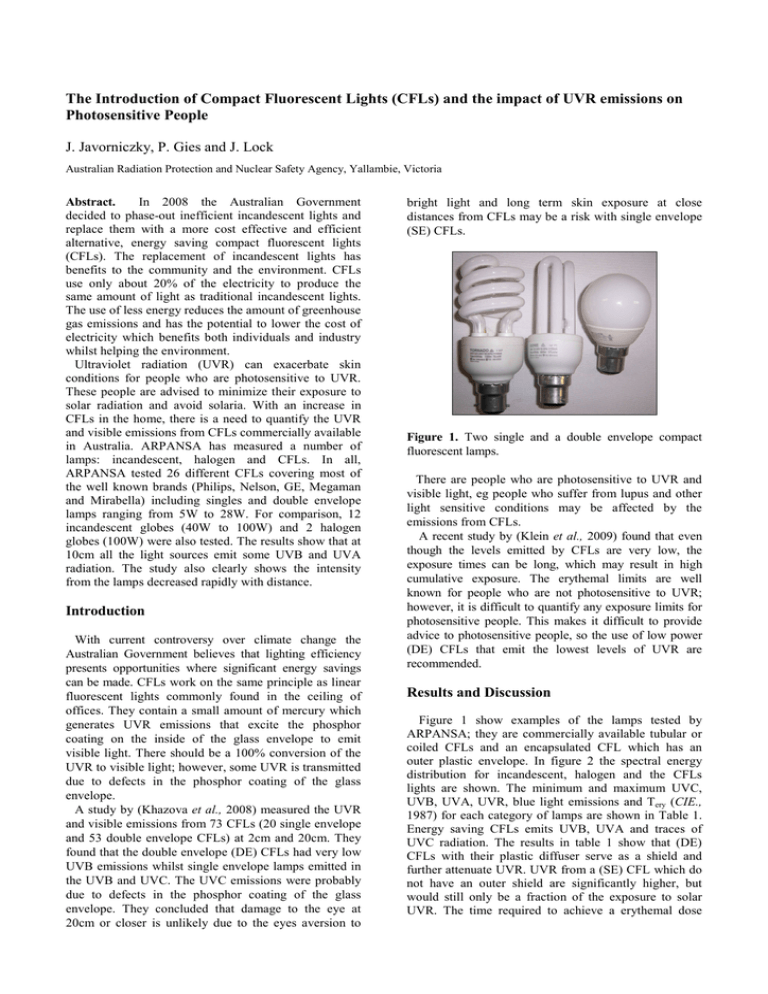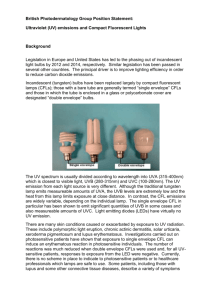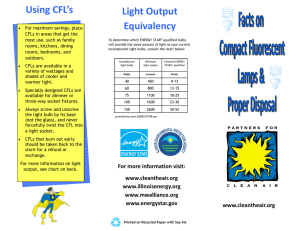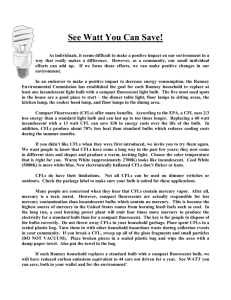The Introduction of Compact Fluorescent Lights (CFLs)
advertisement

The Introduction of Compact Fluorescent Lights (CFLs) and the impact of UVR emissions on Photosensitive People J. Javorniczky, P. Gies and J. Lock Australian Radiation Protection and Nuclear Safety Agency, Yallambie, Victoria Abstract. In 2008 the Australian Government decided to phase-out inefficient incandescent lights and replace them with a more cost effective and efficient alternative, energy saving compact fluorescent lights (CFLs). The replacement of incandescent lights has benefits to the community and the environment. CFLs use only about 20% of the electricity to produce the same amount of light as traditional incandescent lights. The use of less energy reduces the amount of greenhouse gas emissions and has the potential to lower the cost of electricity which benefits both individuals and industry whilst helping the environment. Ultraviolet radiation (UVR) can exacerbate skin conditions for people who are photosensitive to UVR. These people are advised to minimize their exposure to solar radiation and avoid solaria. With an increase in CFLs in the home, there is a need to quantify the UVR and visible emissions from CFLs commercially available in Australia. ARPANSA has measured a number of lamps: incandescent, halogen and CFLs. In all, ARPANSA tested 26 different CFLs covering most of the well known brands (Philips, Nelson, GE, Megaman and Mirabella) including singles and double envelope lamps ranging from 5W to 28W. For comparison, 12 incandescent globes (40W to 100W) and 2 halogen globes (100W) were also tested. The results show that at 10cm all the light sources emit some UVB and UVA radiation. The study also clearly shows the intensity from the lamps decreased rapidly with distance. Introduction With current controversy over climate change the Australian Government believes that lighting efficiency presents opportunities where significant energy savings can be made. CFLs work on the same principle as linear fluorescent lights commonly found in the ceiling of offices. They contain a small amount of mercury which generates UVR emissions that excite the phosphor coating on the inside of the glass envelope to emit visible light. There should be a 100% conversion of the UVR to visible light; however, some UVR is transmitted due to defects in the phosphor coating of the glass envelope. A study by (Khazova et al., 2008) measured the UVR and visible emissions from 73 CFLs (20 single envelope and 53 double envelope CFLs) at 2cm and 20cm. They found that the double envelope (DE) CFLs had very low UVB emissions whilst single envelope lamps emitted in the UVB and UVC. The UVC emissions were probably due to defects in the phosphor coating of the glass envelope. They concluded that damage to the eye at 20cm or closer is unlikely due to the eyes aversion to bright light and long term skin exposure at close distances from CFLs may be a risk with single envelope (SE) CFLs. Figure 1. Two single and a double envelope compact fluorescent lamps. There are people who are photosensitive to UVR and visible light, eg people who suffer from lupus and other light sensitive conditions may be affected by the emissions from CFLs. A recent study by (Klein et al., 2009) found that even though the levels emitted by CFLs are very low, the exposure times can be long, which may result in high cumulative exposure. The erythemal limits are well known for people who are not photosensitive to UVR; however, it is difficult to quantify any exposure limits for photosensitive people. This makes it difficult to provide advice to photosensitive people, so the use of low power (DE) CFLs that emit the lowest levels of UVR are recommended. Results and Discussion Figure 1 show examples of the lamps tested by ARPANSA; they are commercially available tubular or coiled CFLs and an encapsulated CFL which has an outer plastic envelope. In figure 2 the spectral energy distribution for incandescent, halogen and the CFLs lights are shown. The minimum and maximum UVC, UVB, UVA, UVR, blue light emissions and Tery (CIE., 1987) for each category of lamps are shown in Table 1. Energy saving CFLs emits UVB, UVA and traces of UVC radiation. The results in table 1 show that (DE) CFLs with their plastic diffuser serve as a shield and further attenuate UVR. UVR from a (SE) CFL which do not have an outer shield are significantly higher, but would still only be a fraction of the exposure to solar UVR. The time required to achieve a erythemal dose erythemal exposure time (Tery) measured at 10cm of 609 hrs, significantly higher than (SE) CFLs of 114hrs. (Tery) for a 20W (SE) CFL was 7 hours of continuous exposure at 10cm to produce erythema (skin reddening) for a person with skin type I. This is equivalent to 11 minutes of direct exposure at solar noon in Melbourne during summer. Artificial lamps are a major source of blue light which can affect some photosensitive people. Incandescent lamps produce the lowest blue light intensity whilst the (SE) CFLs emit the highest. (DE) CFLs emit lower levels of blue light than (SE) CFLs. The halogen lamps have higher blue light levels than incandescent or (DE) CFLs but less than (SE) CFLs. Conclusions All the lights tested emitted some UVR. • • • • • The (SE) CFLs emitted the highest UVB and UVA, more than incandescent or (DE) CFLs. The (DE) CFLs emitted less UVB than incandescent lamps. The incandescent lamps emitted the least amount of blue light followed by the (DE) CFLs. People who are photosensitive to UVR and blue light should only use (DE) CFLs at distances greater than 25cm. Low UVR emitting (DE) CFLs are available, but it is difficult for photosensitive people to know which (DE) CFLs have the lowest UVR emissions. We are currently working with DEWHA to assess the lowest UVR and blue light emissions from a variety of (DE) CFLs. Acknowledgment Figure 2. UVR and visible spectra of an incandescent, halogen, single envelope (SE) and double envelope (DE) CFLs on a log scale. For comparison the lamps have comparable power outputs. The authors wish to thank the Department of Environment, Water, Heritage and the Arts (DEWHA). UVA levels tend to be high for CFL lamps due to the strong emission at 365nm. Again, the UVA level is lower for the (DE) CFLs than the other lamps due to the outer envelope. The (SE) CFLs has significantly higher UVA and UVB than the other lamps. The (DE) CFLs emit lower UVR than (SE) CFLs; however, most people especially those who are photosensitive to UVR may not know that a (DE) is needed to further reduce the UVR levels emitted by CFLs. The UVR levels for halogen lamps tend to be higher than incandescent and (DE) CFLs and less than (SE) CFLs. The (DE) CFL has an M. Khazova and J.B. O’Hagan., 2008. Optical Radiation Emissions from Compact Fluorescent Lamps, Radiation Protection Dosimetry, pp1-5. References R.S. Klein, V.P. Werth, J.C. Dowdy and R.M. Sayre 2009. Analysis of Compact Fluorescent Lights for use by patients with photosensitive conditions. Photchem. Photobiol. 85: 1004-1010. CIE, 1987. A reference action spectrum for ultraviolet induced erythema in human skin.CIE J. 6, 17–22. Table 1. The UVC, UVB, UVA, UVR and blue light maximum and minimum intensity levels and the CIE weighted (Tery) results for a group of lamps with similar power outputs of 100W. Value in the brackets is the incandescent equivalent. Sources Incandescent 100W Frosted Softone 100W Clear Softone Halogen 100W Frosted Brilliant 100W Clear Brilliant CFLs (SE) 20W (100W) Natural Colour 20W (100W) Warm White CFLs (DE) 18W (100W) Warm White 14W (75W) Warm White Emissions UVC 250-280nm µWcm-2 UVB 280-315nm µWcm-2 UVA 315-400nm µWcm-2 UVR Blue Light 250-400nm 400-495nm µWcm-2 µWcm-2 CIE Tery hrs minimum maximum 0.0E+00 0.0E+00 3.6E-02 2.3E-01 5.0 21.7 5.0 21.9 136 160 521 81 minimum maximum 0.0E+00 0.0E+00 9.5E-02 5.9E-01 14.6 50.5 14.7 51.2 312 318 240 37 minimum maximum 0.0E+00 3.3E-03 6.7E-01 9.8 26.9 62.7 27.6 72.5 501 289 114 7 minimum maximum 0.0E+00 6.9E-04 8.6E-03 1.7E-01 22.5 19.3 22.5 19.5 266 202 609 333




